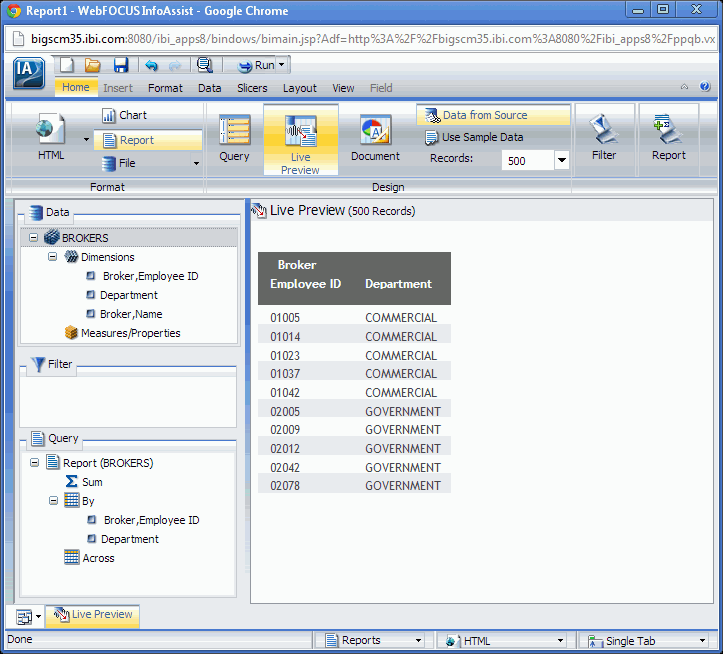By defining a Business View of a Master File, you are creating an alternative view of the Master File and can limit the fields available or create a subset of fields from the original Master File. Fields can be grouped into meaningful folders. Field names, titles, and descriptions can be customized for each Business View.
Fields in a Business View are organized into folders. Each folder contains a group of fields. The fields in a folder can come from different segments in the original Master File. The Business View may contain existing fields and can include existing custom fields for DEFINE, COMPUTE, and Filters. Custom fields are associated with a specific segment in the original Master File and are subject to the same rules as real fields. A report can reference fields from multiple folders if they all lie along a single path in the original Master File.
When opening a Master File in the Synonym Editor and clicking the Business View button on the toolbar, a Business View pane opens inside the Synonym Editor where Business View attributes can be added. Adding Business View attributes at this point would update the Master File by inserting the Business View attributes at the end of the file, and once the file is saved, the Business View becomes the active view when the file is used for reporting.
If you do not wish to turn your Master File into a Business View, it is recommended that you save the Business View using a different name or preferably start by creating a new Master File by selecting New, then Synonym via Synonym Editor. Then, insert a reference to an existing synonym and continue to build the Business View. In this case, the Business View points to the cross-referenced Master File, and all of the actual fields and security information comes from the referenced file when the Business View is used in WebFOCUS tools (such as Joins and Defines) and in reports.
Note: Impact Analysis searches Business Views in addition to FOCUS procedures. This enables you to see if changes in the original Master File will impact fields used in the Business View. For detailed information on Impact Analysis, see Analyzing Metadata and Procedures.
You may create a Business View for an existing Master File by using the Synonym Editor.
x
Procedure: How to Create a Business View Using the Synonym Editor
-
From the Projects or Data Servers area, navigate to the Master Files folder where you want to create the Business View.
-
Right-click the Master Files folder and select New, then Synonym via Synonym Editor.
-
Provide a unique name for the new file and click Open or Create if in the Data Servers area.
-
While in the Field View tab of the Synonym Editor, right-click the file name in the upper-left corner, select Insert, and then Reference to Existing Synonym.
-
From the Insert Reference to Existing Synonym dialog box, select the synonym for which you want to create a Business View. For FOCUS multisegment files, you have the option to select the segment you want to reference.
The referenced file is added to the new synonym and its fields are visible in the left frame.
-
Select Business View from the Tools menu to open the Business View pane. You can also click the Business View icon from the Synonym Editor.
Note: A Business View Master File may contain only one root folder.
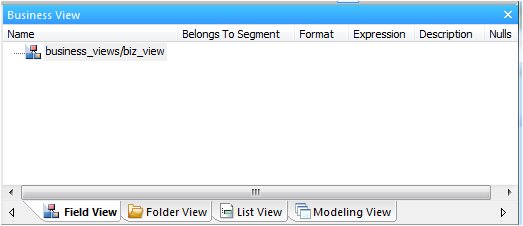
Tip: Select Properties from the Tools menu to open the Properties pane and view additional information for items selected in the Business View pane. Use the Properties pane to change titles, descriptions, or field names. Items that cannot be edited are grayed out.
-
In the Business View pane, right-click the file name and select Create Default Business View or New Folder.
The Create Default Business View option duplicates the segments and fields that are available in the Master File. You can reorganize the view as necessary. The New Folder option creates a root folder to which you can add fields from the Master File on the left pane by selecting them and then dragging them inside the folder. You can create additional folders to create the structure you want.
-
To add additional folders for the Business View, right-click the Business View root folder that was created in the Business View pane and select New Folder.
Note: Multiple subfolders can be created and folders may be empty for organizational purposes.
-
Select fields from the Master File on the left and drag them to the appropriate folder in the Business View pane. Press the Shift or Ctrl key while selecting multiple fields.
Note: If needed, fields may be duplicated by placing them in multiple folders, but any given folder may contain a field only once.
The selected fields appear in the Business View pane.
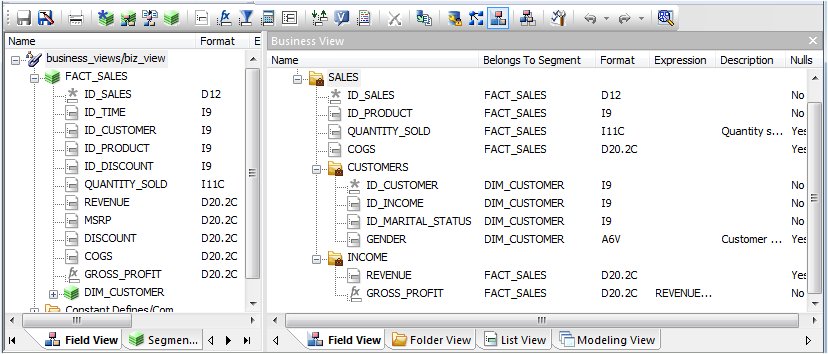
-
Select the Save or Save As icon to save the Business View as a Business View Master File.
Note: The Business View Master File may be saved in a different application than the main files.
x
Procedure: How to Alternatively Create a Business View Using the Synonym Editor
It is recommended that you create a Business View using the Synonym Editor as outlined in How to Create a Business View Using the Synonym Editor. However, the following is an alternative way to create a Business View using the Synonym Editor.
-
From the Projects or Data Servers area, navigate to the Master Files folder where you wish to create the Business View and highlight the Master File to be altered.
Note: You may create a Business View anywhere that you can select a Master File.
-
Double-click the Master File or select Edit in Synonym Editor from the File menu.
The Master File opens to the Field View tab in the Synonym Editor.
Note: When opening a Master File in the Synonym Editor, the tool opens to the last tab selected when the Synonym Editor was last accessed.
-
Select Business View from the Tools menu. You can also click the Business View icon from the Synonym Editor.
The Business View pane opens.
Note: A Business View Master File may contain only one root folder.
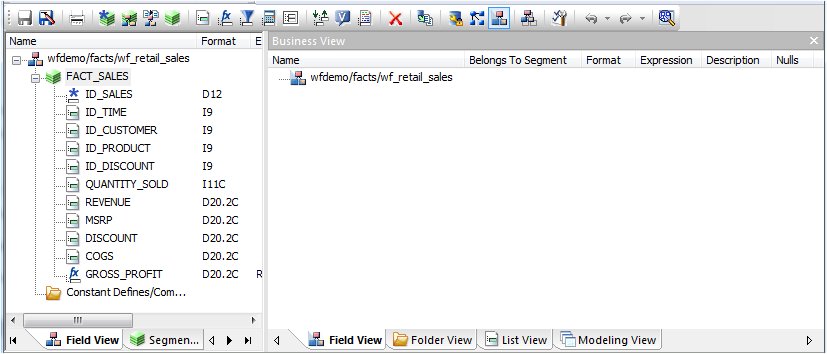
Tip: Select Properties from the Tools menu to open the Properties pane and view additional information for items selected in the Business View pane. Use the Properties pane to change titles, descriptions, or field names. Items that cannot be edited are grayed out.
-
In the Business View pane, right-click the file name and select Create Default Business View or New Folder.
The Create Default Business View option duplicates the segments and fields that are available in the Master File, and you can reorganize the view as necessary. The New Folder option creates a root folder to which you can add fields from the Master File on the left pane by selecting them and then dragging and dropping them inside the folder. You can create additional folders to create the structure you want.
-
To add additional folders for the Business View, right-click the Business View root folder that was created in the Business View pane and select New Folder.
Note: Multiple subfolders can be created and folders may be empty for organizational purposes.
-
Select fields from the Master File on the left and drag and drop them to the appropriate folder in the Business View pane. Press the Shift or Ctrl key while selecting multiple fields.
The selected fields appear in the Business View Tree tab.

Note: If needed, fields may be duplicated by placing them in multiple folders, but any given folder may contain a field only once.
-
Select the Save or Save As icon to save the Business View as a Business View Master File.
When you use the Save As option and you are working with FOCUS files, you will need to specify a DATASET in the Master File that points to the data file.
If you use the Save option, the Business View will be saved inside the current Master File and the Business View will be visible when the Master File is opened in reporting tools.
Note: The Business View Master File may be saved in a different application than the main files.
-
Select Close from the File menu to close to the Synonym Editor.
x
Reference: Usage Notes for Business Views
- When creating a Business View using a referenced Master File:
- The detailed information about fields, such as USAGE and ACTUAL formats or indexes remain in the referenced Master File.
- All information about Cluster Master Files remain in the referenced Master File.
- DBA attributes specified in the referenced Master File are respected by the Business Views
- When a Master File contains more than one field with the same name, as can occur when files are joined, the BELONGS_TO_SEGMENT attribute identifies which instance of the field name is being referenced in the Business View.
- Folders can be empty for organizational purposes. For example, Region can have empty folders called North, South, East, and West.
- You can issue an SQL SELECT command against a Business View. However, a Direct SQL Passthru request is not supported against a Business View.
- Business Views support alternate file views and fully qualified field names.
- The SEG. operator against a Business View folder displays all of the fields in that folder, not all of the fields in the real segment.
- Requests against a Business View cannot reference any fields or segments not in the Business View.
- All HOLD formats are supported against a Business View.
- All adapters for non-FOCUS data sources support retrieval requests against a Business View.
- Business Views are not supported with data source maintenance commands, such as Maintain or REBUILD.
- The referenced Master File or the Master File currently being used to create the Business View, may contain Defines, Computes, Filters, and other fields for use in the Business View.
x
Reference: Using a Business View Master File
When you use the Business View Master File with WebFOCUS tools and reports, the field formats, descriptions, and titles will be retrieved from the original Master File, unless they are customized and a title and description is available through the Business View.
You may access the Business View Master Files from all development areas of Developer Studio.
In the Projects, Data Servers, or Repository area:
The Table List shows all available Master Files, including the Business Views that are available. The Description column shows a description from the Master File or the Business View file.
The following image is an example of a Business View Master File in the WebFOCUS Table List, that appears when creating a report in the Data Servers area.
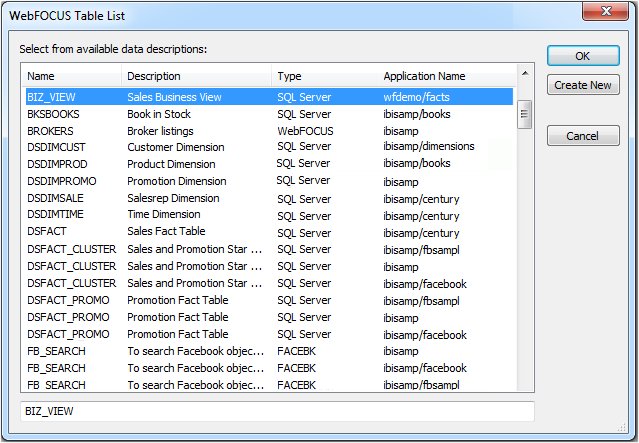
This is also available in the Projects area, however, the Table List does not show remarks in the Projects area.
In Report Painter:
When using a Business View Master File in Report Painter, only fields from the Business View are shown in the Fields list.
The following image is an example of a Business View Master File in Report Painter.
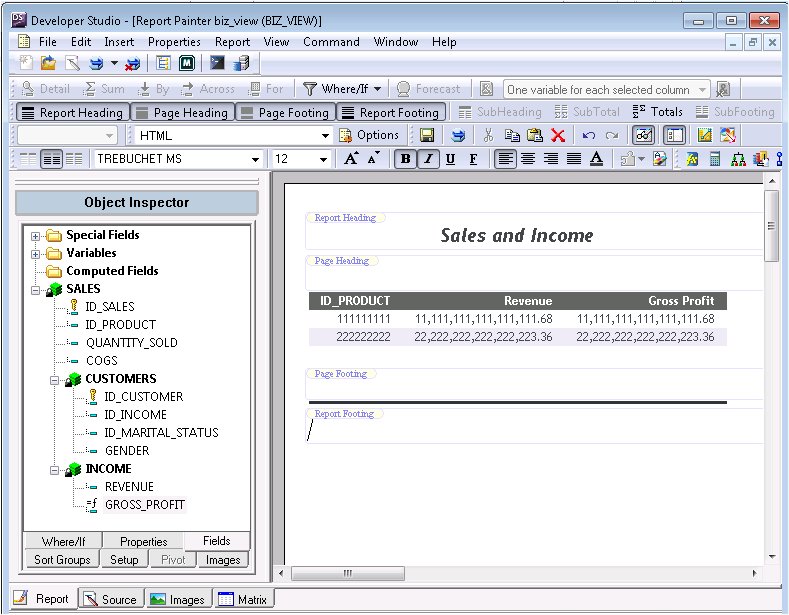
In InfoAssist:
When using a Business View Master File in InfoAssist, only fields from the Business View are shown in the Fields list.
The following image is an example of a Business View Master File in InfoAssist.
